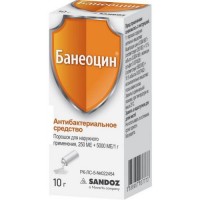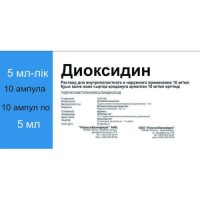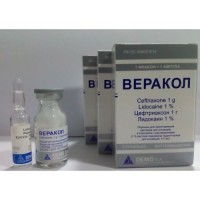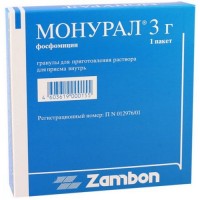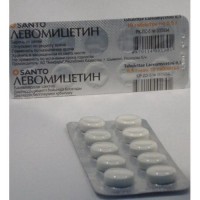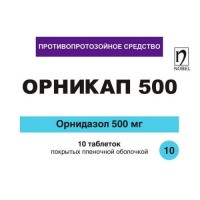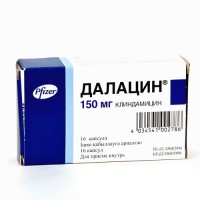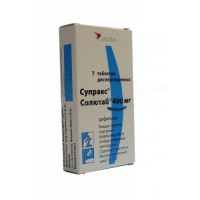Remedy 10s 500 mg film-coated tablets
- $31.40
The instruction
for medical use
of REMEDIA medicine
the Trade name
of Remedia
the International unlicensed
name Levofloxacin Dosage Form
of the Tablet, film coated, 250 mg, 500 mg, 750 mg
Structure
One tablet contains
active agent - a levofloksatsin gemigidrat 256.0 mg, 512.0 mg, or 768.0 mg that is equivalent to a levofloksatsin of 250 mg, 500 mg, or 750 mg respectively,
excipients: microcrystalline cellulose, povidone (K30), krospovidon, silicon dioxide colloidal, magnesium stearate, sodium lauryl sulfate,
structure of a cover: substance for a covering yellow (a gipromelloza, talc, the titan E171 dioxide, gland (ΙΙΙ) oxide yellow E172), propylene glycol.
The description
of the Tablet of oblong shape, with a biconvex surface, film coated yellow color, with the line of a break on one party.
Pharmacotherapeutic group
Antibacterial drugs for system use. Ftorkhinolona.
The code of automatic telephone exchange J01MA12
the Pharmacological
Pharmacokinetics Absorption At properties intake of a levofloksatsin gemigidrat quickly and almost is completely soaked up. Meal is accorded by insignificant effect on absorption of a levofloksatsin. The absolute bioavailability is about 100%. After reception of a single dose of 500 mg of a levofloksatsin the maximum concentration makes 5.2-6.9 mkg/ml, the maximum time - 1.3 h. The pharmacokinetics of a levofloksatsin of the gemigidrat has linear character and is predictable at single and multiple introduction of doses of drug from 50 mg to 600 mg.
Distribution About 30-40% of a levofloksatsin contacts proteins of blood plasma. Well gets into bodies, fabrics and liquids of an organism: lungs, mucous membrane of bronchial tubes, phlegm, bone tissue, bodies of an urinogenital system, polymorphonuclear leukocytes, alveolar macrophages. Cmax after reception of 500 mg of a levofloksatsin in a mucous membrane of bronchial tubes is reached in 1 hour in limits 8.3mkg/g, in pulmonary fabric in 4-6 hours – 11.3mkg/g, in a bladder in 2-4 hours – 4.0mkg/g. Levofloxacin poorly gets into cerebrospinal fluid. Average concentration in urine after reception of 150 mg, 300 mg or 500 mg of a levofloksatsin in 8-12 hours there were 44mg/l, 91 mg/l and 200 mg/l respectively.
Metabolism In a liver a small part is oxidized and/or dezatsetilirutsya with formation of metabolites: desmezil-levofloxacin and N-oxide levofloxacin.
Removal
Elimination half-life (T1/2) after one-time and repeated introduction - 6.4±0.7ч. It is brought out of an organism mainly by kidneys (by glomerular filtration and canalicular secretion) and intestines. Less than 5% of a levofloksatsin are excreted in the form of metabolites. In not changed view with urine during 24 h 70% and for 48 h - 87% are removed, in Calais for 72 h 4% of the dose accepted inside are found. In a renal failure the reduction of clearance of drug and its removal through kidneys depends on extent of decrease in the clearance of creatinine (CC). At KK 50-80ml/min T1/2 – 9 h, at KK of 20-40 ml/min. T1/2 – 27 h, at KK less than 20 ml/min. of T1/2 – 35 h.
There are no serious differences in pharmacokinetics of a levofloksatsin after intravenous administration and intake, it is supposed that intake and intravenous administration are interchangeable.
A pharmacodynamics
of Remedia - antimicrobial microbicide of a broad spectrum of activity which active agent - levofloxacin - is left-handed isomer of an ofloksatsin. Levofloxacin blocks a DNA-giraza (topoisomerase II) and topoisomerase IV, breaks superspiralling and a stitching of ruptures of DNA, inhibits DNA synthesis, causes profound morphological changes in cytoplasm, a cell wall and membranes of bacteria.
Levofloxacin is active concerning the majority of strains
of microorganisms as in the conditions of in vitro and in vivo.
Activity of in vitro:
Sensitive microorganisms (minimum overwhelming concentration less 2mg/l)
Aerobic gram-positive microorganisms: Enterococcus faecalis, Staphylococcus coagulase-negative methi-S(I)
, Staphylococcus aureus methi-S, Staphylococcus epidermidis methi-S, Staphylococcus spp (CNS), Streptococci of group C and G, Streptococcus agalactiae, Streptococcus pneumoniae peni I/S/R (penitsillino - chuvstvitelnye/-moderately sensitive/resistant), Streptococcus pyogenes, Viridans streptococci peni-S/R, Streptococcus faecalis.
Aerobic gram-negative microorganisms: Acinetobacter baumannil, Acinetobacter calcoaceticus, Enterobacter aerogenes, Enterobacter agglomerans, Enterobacter cloacae, Enterobacter spp, Escherichia coli, Haemophilus ducreyi, Haemophilus influenzae ampi-S/R (ampitsillino-chuvstviyeljnye/-resistant), Haemophilus parainfluenzae, Klebsiella oxytoca, Klebsiella pneumoniae, Klebsiella spp, Moraxela catarrhalis/?+//? - Proteus mirabilis, Proteus vulgaris, Pseudomonas aeruginosa, Serratia marcescens.
Anaerobic microorganisms: Bacteroides fragilis, Bifidobacterium spp, Clostridium perfringens, Fusobacterium spp, Peptostreptococcus, Propionibacterum spp, Veilonella spp.
Other microorganisms: Chlamydia pneumoniae, Chlamydia psittaci, Chlamydia trachomatis, Legionella pneumophila, Mycoplasma hominis, Mycoplasma pneumoniae, Ureaplasma urealyticum.
Moderately and poorly sensitive microorganisms (minimum overwhelming concentration> of 4-8 mg/l)
Aerobic gram-positive microorganisms: Corynebacterium urealiticum, Corynebacterium xerosis, Enterococcus faecium, Staphylococcus epidermidis methi-R (metitsillino-resistant), Staphylococcus haemolyticus methi-R.
Aerobic gram-negative microorganisms: Burkholderia cepacia, Campilobacter jejuni/coli.
Anaerobic microorganisms: Bacteroides thetaiotaomicron, Bacteroides vulgatus, Bacteroides ovaius, Prevotella spp, Porphyromonas spp.
Insensitive microorganisms (minimum overwhelming concentration> of 8 mg/l)
Aerobic gram-positive microorganisms: Corynebacterium jeikeium, Staphylococcus aureus methi-R, Staphylococcus coagulase-negative methi-R.
Aerobic gram-negative microorganisms: Alcaligenes xylosoxidans.
Other microorganisms: Mycobacterium avium.
In vitro is possible cross resistance between levofloksatsiny and other ftorkhinolona. The cross resistance between levofloksatsiny and other classes of antibacterial agents is excluded.
Indications
Treatment of infections easy and moderate severity, caused by sensitive microorganisms, at adults:
- lower respiratory tract infections: community-acquired pneumonia, exacerbation of chronic bronchitis
- acute sinusitis
- the complicated infection of urinary tract, including pyelonephritis
- chronic bacterial prostatitis
- infections of skin and soft tissues
appoint the Route of administration and doses of Remedia of a tablet the adult 1-2 times a day.
The dosage depends on type and severity of an infection, sensitivity of the assumed or allocated microorganism which is an infestant.
Duration of treatment varies depending on a disease with the maximum duration of treatment of 14 days, in bacterial prostatitis it is possible up to 28 days.
According to the general principles of antibacterial therapy, reception of Remedia of a tablet has to be continued within at least 48-72 hours after normalization of body temperature or obtaining the negative bacteriological analysis.
The Remedi of a tablet is accepted inside, without chewing, with enough liquid. For the recommended dosing of a tablet can be divided in the area of a break. A pill can be taken during meal or between meal. The Remedia a pill has to be taken in 2 hours prior to intake of salts of iron, antacids and the sukralfat in connection with possible decrease in absorption.
The scheme of reception Remedia for patients with normal function of kidneys (Clearance of creatinine> of 50 ml/min.)
Indications
the Dose
Duration
Acute sinusitis
of 500 mg once a day
10-14 days
Exacerbation of chronic bronchitis
of 250 - 500 mg once a day
7-10 days
Community-acquired pneumonia
of 500 mg 1 or 2 times a day
7-14 days
the Complicated infection of urinary tract, including pyelonephritis
of 250 mg once a day
7-10 days
Chronic bacterial prostatitis
on 500 mg once a day
28 days
of the Infection of skin and soft tissues
of 250 mg once a day or 500 mg 1 or 2 times a day
7-14 days
the Scheme of reception Remedia for patients with a renal failure (Clearance of creatinine ≤ 50 ml/min.)
Doses, frequency rate
of 250 mg / 24 h
500 mg / 24 h
500 mg / 12 h
Clearance of creatinine
the First dose: 250 mg
the First dose: 500 mg
the First dose:
500
mg 50-20 ml/min.
Then:
125 mg / 24 h
Then:
250 mg / 24 h
Then:
250 mg / 12 h
19-10 ml/min.
Then:
125 mg / 48 h
Then:
125 mg / 24 h
Then:
125 mg / 12 h
Then:
125 mg / 48 h
Then:
125 mg / 24 h
Then:
125 /24 h
*-are not required introduction of the additional doses recommended after a hemodialysis or the continuous out-patient peritoneal dialysis (COPPD).
Side effects
Often (1-10%)
- nausea, diarrhea
- increase in level of liver enzymes (for example, ALT, nuclear heating plant)
- local irritation, pain and reddening on the party of an injection, phlebitis
not often (0.1-1%)
- digestion disturbance, a loss of appetite, an abdominal pain
- a headache, dizziness, weakness, drowsiness, insomnia, catalepsy
- an eosinophilia, a leukopenia
- an itching, rash
- increase in bilirubin, increase in level of creatinine in blood serum
- reproduction of fungal flora and distribution of other resistant microorganisms, dysbacteriosis
Seldom (0.01-0.1%)
- urticaria, bronchospasm / short wind
- diarrhea with impurity of blood which seldom or never can testify to a coloenteritis, including pseudomembranous colitis
- tachycardia, arterial hypotension
- arthralgias, myalgias, damages of sinews, including tendinites (for example, damages of an Achilles sinew)
- a neutropenia, thrombocytopenia
- a tremor, concern, paresthesias, fear, hallucinations, confusion of consciousness, a depression, motive disorders, spasms
Very seldom (less than 0.01%)
- vascular collapse
- pseudomembranous colitis
- hepatitis
- interstitial nephrite, an acute renal failure
- reactions of hypersensitivity: the photosensitization, dropsy of cutaneous and mucous membranes, a Quincke's disease, an acute anaphylaxis, an allergic pneumonitis
- disorders of vision, hearing, sense of smell, flavoring and tactile sensitivity
- a hypoglycemia (increase in appetite, the increased sweating, a shiver), especially at patients with diabetes
- a rupture of sinews (for example, an Achilles sinew), as well as at use of other ftorkhinolon, this undesirable effect can occur within 48 hours after an initiation of treatment and can be bilateral
- myalgia, muscle weakness which can be of particular importance at patients with myasthenias
- an agranulocytosis
- fever
Isolated cases
- a heavy enanthesis with formation of bubbles, such as Stephens-Johnson's syndrome, toxic epidermal necrolysis (Lyell's disease) and multiformny exudative erythema
- mental reactions with autoaggressive behavior, including suicide thoughts or actions
- a rhabdomyolysis
- hemolytic anemia, a pancytopenia
- lengthening of an interval of Q-T
Other undesirable effects connected by use of ftorkhinolon
- mental reactions, such as sharp twilight and depressions of change of mood (these reactions can arise even after reception of the first dose)
- extrapyramidal symptoms and other disorders of muscular coordination - a hyper sensitive vasculitis
- porphyria attacks at patients with
the Contraindication porphyria
- hypersensitivity to a levofloksatsin, other hinolona or any of excipients
- epilepsy
- the damage of sinews in the anamnesis connected with purpose of ftorkhinolon
- children's and teenage age up to 18 years
- pregnancy and the period of a lactation
Medicinal interactions
of Salt of iron, magnesium or aluminum the containing antacids
Absorption of a levofloksatsin considerably decreases at co-administration of salts of iron, magnesium - or aluminum-bearing antacids with Remedia's tablets. It is recommended to accept the drugs containing bivalent cations, such as iron salts, either magnesium or aluminum the containing antacids in 2 hours prior to or after Remedia's reception of tablets. Interaction from calcium was not found a carbonate.
Sukralfat
Biodostupnost Remedia of tablets considerably decreases at reception along with sukralfaty. If the patient accepts at the same time sukralfat and Remedia, it is better to accept sukralfat in 2 hours after Remedia's reception tablets.
Theophylline, fenbufen or similar non-steroidal anti-inflammatory drugs
pharmacokinetic interactions of a levofloksatsin with theophylline were Not found in clinical trial. Nevertheless, there can be a significant reduction of the threshold of cerebral sensitivity, at a concomitant use of ftorkhinolon to the theophylline, non-steroidal anti-inflammatory drugs or other means reducing a threshold of convulsive readiness.
Concentration of a levofloksatsin were about 13% and above, in the presence of a fenbufen, than at intake of one drug Remedia.
Probenetsid and
Probenetsid Cimetidinum and Cimetidinum renders significant effect on elimination of a levofloksatsin. The renal clearance of a levofloksatsin was reduced at reception with Cimetidinum (24%) and with probenetsidy (34%). This results from the fact that both drugs are capable to block secretion of a levofloksatsin in renal tubules. Nevertheless, on the tested doses in a research, significant kinetic distinctions have no clinical value.
It is necessary to be careful at co-administration of a levofloksatsin with the drugs influencing glomerular secretion of kidneys such as probenetsid and Cimetidinum, especially at patients with disturbances of kidneys.
Cyclosporine the Half-life period of cyclosporine was increased by 33%, at co-administration with levofloksatsiny.
Antagonists of vitamin K
Increase in coagulative tests (PT/INR) and/or bleedings which can be heavy were registered at the patients treated levofloksatsiny in a combination with antagonists of vitamin K (for example, warfarin). Therefore monitoring of coagulative tests at the patients accepting at the same time antagonists of vitamin K has to be carried out.
Special indications
of Remedia of a tablet are contraindicated to the patients having epilepsy in the anamnesis. As well as when assigning other ftorkhinolon, it is necessary to use with extra care at the patients predisposed to spasms at patients with already existing disturbance of the central nervous system, with joint reception of a fenbufen and similar non-steroidal anti-inflammatory drugs or drugs which reduce a cerebral threshold of convulsive readiness, such as theophylline.
Patients with latent or actual insufficiency glyukozo-6-phosphate of dehydrogenase can be subject to hemolytic reactions at treatment by antibacterial agents of group of ftorkhinolon therefore Remedia should be used with care.
For prevention of development of a photosensitization it is recommended that patients were not exposed to strong influence of sunshine or artificial ultraviolet radiation (for example, a quartz lamp, a sunbed).
At suspicion of pseudomembranous colitis it is necessary to cancel immediately Remedia and to begin the corresponding treatment. In such cases it is impossible to apply the medicines oppressing motility of intestines.
The tendinitis which is seldom observed at use of ftorkhinolon (first of all, inflammation of an Achilles tendon) can lead to a rupture of sinews. Patients of advanced age are more inclined to a tendinitis. Treatment by glucocorticosteroids increases risk of a rupture of sinews. At suspicion of a tendinitis it is necessary to stop immediately the Remedia drug treatment and to begin the corresponding treatment of the affected sinew, for example, having provided it a condition of rest.
The Remedia can delay growth of Mycobacterium tuberculosis therefore false-negative results in a bacteriological research for tuberculosis detection are possible.
At the heavy community-acquired pneumonia caused by Streptococcus pneumoniae, Remedia can not give optimum therapeutic effect.
Use in pediatrics
Drug cannot be used for treatment of children and teenagers in view of the probability of damage of articulate cartilages.
Use for patients with an abnormal liver function
In an abnormal liver function is not required special selection of doses as levofloxacin is metabolized in a liver only in extremely insignificant measure.
Use for patients of advanced age
For patients of advanced age is not required changes of the mode of dosing, except for cases of low clearance of creatinine.
Features of influence of medicine on ability to run the vehicle and potentially dangerous mechanisms
Even when drug is used according to the instruction, it can change reaction to such an extent that the ability to drive or operate the vehicles can be broken. Such side effects of the drug Remedia as dizziness or catalepsy, drowsiness and visual disturbances, can worsen reactionary ability and ability to concentration of attention. It can represent a certain risk when driving, at service of machines and mechanisms, when working in unstable situation. In a special measure it concerns cases of interaction of drug with alcohol.
Overdose
Symptoms: nausea, erosive damages of mucous membranes of a GIT, lengthening of an interval of Q-T, confusion of consciousness, dizziness, spasms.
Treatment: symptomatic, dialysis is inefficient.
A form of release and packing
On 5 or 10 tablets in blister strip packaging from a film of polyvinylchloride and aluminum foil.
On 1 planimetric packing together with the instruction for medical use in the state and Russian languages put in a pack from cardboard.
To Store storage conditions out of children's reach!
At a temperature not over 25 ºС, in the place protected from light.
3 years
not to apply a period of storage after the expiry date specified on packing.
Prescription status
According to the prescription
of Proizvoditel SIMPEX FARM Pvt. Ltd.
B-4/160, Safdarzhang the Enclave, New Delhi – 110,029, India
the Plant: 288, Sidko Estet, Ambattur, Chennay - 600,098, India
the Owner of the registration certificate
of SIMPEX FARM Pvt. Ltd.
The address of the organization accepting in the territory of the Republic of Kazakhstan claims from consumers on quality of products (goods)
of Koral-Med Kazakhstan LLP
Almaty, Auezov St. 3
Ph./fax + 7 727 266 95 50
E-mail:
To Develop coralmedkz@mail.ru
for medical use
of REMEDIA medicine
the Trade name
of Remedia
the International unlicensed
name Levofloxacin Dosage Form
of the Tablet, film coated, 250 mg, 500 mg, 750 mg
Structure
One tablet contains
active agent - a levofloksatsin gemigidrat 256.0 mg, 512.0 mg, or 768.0 mg that is equivalent to a levofloksatsin of 250 mg, 500 mg, or 750 mg respectively,
excipients: microcrystalline cellulose, povidone (K30), krospovidon, silicon dioxide colloidal, magnesium stearate, sodium lauryl sulfate,
structure of a cover: substance for a covering yellow (a gipromelloza, talc, the titan E171 dioxide, gland (ΙΙΙ) oxide yellow E172), propylene glycol.
The description
of the Tablet of oblong shape, with a biconvex surface, film coated yellow color, with the line of a break on one party.
Pharmacotherapeutic group
Antibacterial drugs for system use. Ftorkhinolona.
The code of automatic telephone exchange J01MA12
the Pharmacological
Pharmacokinetics Absorption At properties intake of a levofloksatsin gemigidrat quickly and almost is completely soaked up. Meal is accorded by insignificant effect on absorption of a levofloksatsin. The absolute bioavailability is about 100%. After reception of a single dose of 500 mg of a levofloksatsin the maximum concentration makes 5.2-6.9 mkg/ml, the maximum time - 1.3 h. The pharmacokinetics of a levofloksatsin of the gemigidrat has linear character and is predictable at single and multiple introduction of doses of drug from 50 mg to 600 mg.
Distribution About 30-40% of a levofloksatsin contacts proteins of blood plasma. Well gets into bodies, fabrics and liquids of an organism: lungs, mucous membrane of bronchial tubes, phlegm, bone tissue, bodies of an urinogenital system, polymorphonuclear leukocytes, alveolar macrophages. Cmax after reception of 500 mg of a levofloksatsin in a mucous membrane of bronchial tubes is reached in 1 hour in limits 8.3mkg/g, in pulmonary fabric in 4-6 hours – 11.3mkg/g, in a bladder in 2-4 hours – 4.0mkg/g. Levofloxacin poorly gets into cerebrospinal fluid. Average concentration in urine after reception of 150 mg, 300 mg or 500 mg of a levofloksatsin in 8-12 hours there were 44mg/l, 91 mg/l and 200 mg/l respectively.
Metabolism In a liver a small part is oxidized and/or dezatsetilirutsya with formation of metabolites: desmezil-levofloxacin and N-oxide levofloxacin.
Removal
Elimination half-life (T1/2) after one-time and repeated introduction - 6.4±0.7ч. It is brought out of an organism mainly by kidneys (by glomerular filtration and canalicular secretion) and intestines. Less than 5% of a levofloksatsin are excreted in the form of metabolites. In not changed view with urine during 24 h 70% and for 48 h - 87% are removed, in Calais for 72 h 4% of the dose accepted inside are found. In a renal failure the reduction of clearance of drug and its removal through kidneys depends on extent of decrease in the clearance of creatinine (CC). At KK 50-80ml/min T1/2 – 9 h, at KK of 20-40 ml/min. T1/2 – 27 h, at KK less than 20 ml/min. of T1/2 – 35 h.
There are no serious differences in pharmacokinetics of a levofloksatsin after intravenous administration and intake, it is supposed that intake and intravenous administration are interchangeable.
A pharmacodynamics
of Remedia - antimicrobial microbicide of a broad spectrum of activity which active agent - levofloxacin - is left-handed isomer of an ofloksatsin. Levofloxacin blocks a DNA-giraza (topoisomerase II) and topoisomerase IV, breaks superspiralling and a stitching of ruptures of DNA, inhibits DNA synthesis, causes profound morphological changes in cytoplasm, a cell wall and membranes of bacteria.
Levofloxacin is active concerning the majority of strains
of microorganisms as in the conditions of in vitro and in vivo.
Activity of in vitro:
Sensitive microorganisms (minimum overwhelming concentration less 2mg/l)
Aerobic gram-positive microorganisms: Enterococcus faecalis, Staphylococcus coagulase-negative methi-S(I)
, Staphylococcus aureus methi-S, Staphylococcus epidermidis methi-S, Staphylococcus spp (CNS), Streptococci of group C and G, Streptococcus agalactiae, Streptococcus pneumoniae peni I/S/R (penitsillino - chuvstvitelnye/-moderately sensitive/resistant), Streptococcus pyogenes, Viridans streptococci peni-S/R, Streptococcus faecalis.
Aerobic gram-negative microorganisms: Acinetobacter baumannil, Acinetobacter calcoaceticus, Enterobacter aerogenes, Enterobacter agglomerans, Enterobacter cloacae, Enterobacter spp, Escherichia coli, Haemophilus ducreyi, Haemophilus influenzae ampi-S/R (ampitsillino-chuvstviyeljnye/-resistant), Haemophilus parainfluenzae, Klebsiella oxytoca, Klebsiella pneumoniae, Klebsiella spp, Moraxela catarrhalis/?+//? - Proteus mirabilis, Proteus vulgaris, Pseudomonas aeruginosa, Serratia marcescens.
Anaerobic microorganisms: Bacteroides fragilis, Bifidobacterium spp, Clostridium perfringens, Fusobacterium spp, Peptostreptococcus, Propionibacterum spp, Veilonella spp.
Other microorganisms: Chlamydia pneumoniae, Chlamydia psittaci, Chlamydia trachomatis, Legionella pneumophila, Mycoplasma hominis, Mycoplasma pneumoniae, Ureaplasma urealyticum.
Moderately and poorly sensitive microorganisms (minimum overwhelming concentration> of 4-8 mg/l)
Aerobic gram-positive microorganisms: Corynebacterium urealiticum, Corynebacterium xerosis, Enterococcus faecium, Staphylococcus epidermidis methi-R (metitsillino-resistant), Staphylococcus haemolyticus methi-R.
Aerobic gram-negative microorganisms: Burkholderia cepacia, Campilobacter jejuni/coli.
Anaerobic microorganisms: Bacteroides thetaiotaomicron, Bacteroides vulgatus, Bacteroides ovaius, Prevotella spp, Porphyromonas spp.
Insensitive microorganisms (minimum overwhelming concentration> of 8 mg/l)
Aerobic gram-positive microorganisms: Corynebacterium jeikeium, Staphylococcus aureus methi-R, Staphylococcus coagulase-negative methi-R.
Aerobic gram-negative microorganisms: Alcaligenes xylosoxidans.
Other microorganisms: Mycobacterium avium.
In vitro is possible cross resistance between levofloksatsiny and other ftorkhinolona. The cross resistance between levofloksatsiny and other classes of antibacterial agents is excluded.
Indications
Treatment of infections easy and moderate severity, caused by sensitive microorganisms, at adults:
- lower respiratory tract infections: community-acquired pneumonia, exacerbation of chronic bronchitis
- acute sinusitis
- the complicated infection of urinary tract, including pyelonephritis
- chronic bacterial prostatitis
- infections of skin and soft tissues
appoint the Route of administration and doses of Remedia of a tablet the adult 1-2 times a day.
The dosage depends on type and severity of an infection, sensitivity of the assumed or allocated microorganism which is an infestant.
Duration of treatment varies depending on a disease with the maximum duration of treatment of 14 days, in bacterial prostatitis it is possible up to 28 days.
According to the general principles of antibacterial therapy, reception of Remedia of a tablet has to be continued within at least 48-72 hours after normalization of body temperature or obtaining the negative bacteriological analysis.
The Remedi of a tablet is accepted inside, without chewing, with enough liquid. For the recommended dosing of a tablet can be divided in the area of a break. A pill can be taken during meal or between meal. The Remedia a pill has to be taken in 2 hours prior to intake of salts of iron, antacids and the sukralfat in connection with possible decrease in absorption.
The scheme of reception Remedia for patients with normal function of kidneys (Clearance of creatinine> of 50 ml/min.)
Indications
the Dose
Duration
Acute sinusitis
of 500 mg once a day
10-14 days
Exacerbation of chronic bronchitis
of 250 - 500 mg once a day
7-10 days
Community-acquired pneumonia
of 500 mg 1 or 2 times a day
7-14 days
the Complicated infection of urinary tract, including pyelonephritis
of 250 mg once a day
7-10 days
Chronic bacterial prostatitis
on 500 mg once a day
28 days
of the Infection of skin and soft tissues
of 250 mg once a day or 500 mg 1 or 2 times a day
7-14 days
the Scheme of reception Remedia for patients with a renal failure (Clearance of creatinine ≤ 50 ml/min.)
Doses, frequency rate
of 250 mg / 24 h
500 mg / 24 h
500 mg / 12 h
Clearance of creatinine
the First dose: 250 mg
the First dose: 500 mg
the First dose:
500
mg 50-20 ml/min.
Then:
125 mg / 24 h
Then:
250 mg / 24 h
Then:
250 mg / 12 h
19-10 ml/min.
Then:
125 mg / 48 h
Then:
125 mg / 24 h
Then:
125 mg / 12 h
Then:
125 mg / 48 h
Then:
125 mg / 24 h
Then:
125 /24 h
*-are not required introduction of the additional doses recommended after a hemodialysis or the continuous out-patient peritoneal dialysis (COPPD).
Side effects
Often (1-10%)
- nausea, diarrhea
- increase in level of liver enzymes (for example, ALT, nuclear heating plant)
- local irritation, pain and reddening on the party of an injection, phlebitis
not often (0.1-1%)
- digestion disturbance, a loss of appetite, an abdominal pain
- a headache, dizziness, weakness, drowsiness, insomnia, catalepsy
- an eosinophilia, a leukopenia
- an itching, rash
- increase in bilirubin, increase in level of creatinine in blood serum
- reproduction of fungal flora and distribution of other resistant microorganisms, dysbacteriosis
Seldom (0.01-0.1%)
- urticaria, bronchospasm / short wind
- diarrhea with impurity of blood which seldom or never can testify to a coloenteritis, including pseudomembranous colitis
- tachycardia, arterial hypotension
- arthralgias, myalgias, damages of sinews, including tendinites (for example, damages of an Achilles sinew)
- a neutropenia, thrombocytopenia
- a tremor, concern, paresthesias, fear, hallucinations, confusion of consciousness, a depression, motive disorders, spasms
Very seldom (less than 0.01%)
- vascular collapse
- pseudomembranous colitis
- hepatitis
- interstitial nephrite, an acute renal failure
- reactions of hypersensitivity: the photosensitization, dropsy of cutaneous and mucous membranes, a Quincke's disease, an acute anaphylaxis, an allergic pneumonitis
- disorders of vision, hearing, sense of smell, flavoring and tactile sensitivity
- a hypoglycemia (increase in appetite, the increased sweating, a shiver), especially at patients with diabetes
- a rupture of sinews (for example, an Achilles sinew), as well as at use of other ftorkhinolon, this undesirable effect can occur within 48 hours after an initiation of treatment and can be bilateral
- myalgia, muscle weakness which can be of particular importance at patients with myasthenias
- an agranulocytosis
- fever
Isolated cases
- a heavy enanthesis with formation of bubbles, such as Stephens-Johnson's syndrome, toxic epidermal necrolysis (Lyell's disease) and multiformny exudative erythema
- mental reactions with autoaggressive behavior, including suicide thoughts or actions
- a rhabdomyolysis
- hemolytic anemia, a pancytopenia
- lengthening of an interval of Q-T
Other undesirable effects connected by use of ftorkhinolon
- mental reactions, such as sharp twilight and depressions of change of mood (these reactions can arise even after reception of the first dose)
- extrapyramidal symptoms and other disorders of muscular coordination - a hyper sensitive vasculitis
- porphyria attacks at patients with
the Contraindication porphyria
- hypersensitivity to a levofloksatsin, other hinolona or any of excipients
- epilepsy
- the damage of sinews in the anamnesis connected with purpose of ftorkhinolon
- children's and teenage age up to 18 years
- pregnancy and the period of a lactation
Medicinal interactions
of Salt of iron, magnesium or aluminum the containing antacids
Absorption of a levofloksatsin considerably decreases at co-administration of salts of iron, magnesium - or aluminum-bearing antacids with Remedia's tablets. It is recommended to accept the drugs containing bivalent cations, such as iron salts, either magnesium or aluminum the containing antacids in 2 hours prior to or after Remedia's reception of tablets. Interaction from calcium was not found a carbonate.
Sukralfat
Biodostupnost Remedia of tablets considerably decreases at reception along with sukralfaty. If the patient accepts at the same time sukralfat and Remedia, it is better to accept sukralfat in 2 hours after Remedia's reception tablets.
Theophylline, fenbufen or similar non-steroidal anti-inflammatory drugs
pharmacokinetic interactions of a levofloksatsin with theophylline were Not found in clinical trial. Nevertheless, there can be a significant reduction of the threshold of cerebral sensitivity, at a concomitant use of ftorkhinolon to the theophylline, non-steroidal anti-inflammatory drugs or other means reducing a threshold of convulsive readiness.
Concentration of a levofloksatsin were about 13% and above, in the presence of a fenbufen, than at intake of one drug Remedia.
Probenetsid and
Probenetsid Cimetidinum and Cimetidinum renders significant effect on elimination of a levofloksatsin. The renal clearance of a levofloksatsin was reduced at reception with Cimetidinum (24%) and with probenetsidy (34%). This results from the fact that both drugs are capable to block secretion of a levofloksatsin in renal tubules. Nevertheless, on the tested doses in a research, significant kinetic distinctions have no clinical value.
It is necessary to be careful at co-administration of a levofloksatsin with the drugs influencing glomerular secretion of kidneys such as probenetsid and Cimetidinum, especially at patients with disturbances of kidneys.
Cyclosporine the Half-life period of cyclosporine was increased by 33%, at co-administration with levofloksatsiny.
Antagonists of vitamin K
Increase in coagulative tests (PT/INR) and/or bleedings which can be heavy were registered at the patients treated levofloksatsiny in a combination with antagonists of vitamin K (for example, warfarin). Therefore monitoring of coagulative tests at the patients accepting at the same time antagonists of vitamin K has to be carried out.
Special indications
of Remedia of a tablet are contraindicated to the patients having epilepsy in the anamnesis. As well as when assigning other ftorkhinolon, it is necessary to use with extra care at the patients predisposed to spasms at patients with already existing disturbance of the central nervous system, with joint reception of a fenbufen and similar non-steroidal anti-inflammatory drugs or drugs which reduce a cerebral threshold of convulsive readiness, such as theophylline.
Patients with latent or actual insufficiency glyukozo-6-phosphate of dehydrogenase can be subject to hemolytic reactions at treatment by antibacterial agents of group of ftorkhinolon therefore Remedia should be used with care.
For prevention of development of a photosensitization it is recommended that patients were not exposed to strong influence of sunshine or artificial ultraviolet radiation (for example, a quartz lamp, a sunbed).
At suspicion of pseudomembranous colitis it is necessary to cancel immediately Remedia and to begin the corresponding treatment. In such cases it is impossible to apply the medicines oppressing motility of intestines.
The tendinitis which is seldom observed at use of ftorkhinolon (first of all, inflammation of an Achilles tendon) can lead to a rupture of sinews. Patients of advanced age are more inclined to a tendinitis. Treatment by glucocorticosteroids increases risk of a rupture of sinews. At suspicion of a tendinitis it is necessary to stop immediately the Remedia drug treatment and to begin the corresponding treatment of the affected sinew, for example, having provided it a condition of rest.
The Remedia can delay growth of Mycobacterium tuberculosis therefore false-negative results in a bacteriological research for tuberculosis detection are possible.
At the heavy community-acquired pneumonia caused by Streptococcus pneumoniae, Remedia can not give optimum therapeutic effect.
Use in pediatrics
Drug cannot be used for treatment of children and teenagers in view of the probability of damage of articulate cartilages.
Use for patients with an abnormal liver function
In an abnormal liver function is not required special selection of doses as levofloxacin is metabolized in a liver only in extremely insignificant measure.
Use for patients of advanced age
For patients of advanced age is not required changes of the mode of dosing, except for cases of low clearance of creatinine.
Features of influence of medicine on ability to run the vehicle and potentially dangerous mechanisms
Even when drug is used according to the instruction, it can change reaction to such an extent that the ability to drive or operate the vehicles can be broken. Such side effects of the drug Remedia as dizziness or catalepsy, drowsiness and visual disturbances, can worsen reactionary ability and ability to concentration of attention. It can represent a certain risk when driving, at service of machines and mechanisms, when working in unstable situation. In a special measure it concerns cases of interaction of drug with alcohol.
Overdose
Symptoms: nausea, erosive damages of mucous membranes of a GIT, lengthening of an interval of Q-T, confusion of consciousness, dizziness, spasms.
Treatment: symptomatic, dialysis is inefficient.
A form of release and packing
On 5 or 10 tablets in blister strip packaging from a film of polyvinylchloride and aluminum foil.
On 1 planimetric packing together with the instruction for medical use in the state and Russian languages put in a pack from cardboard.
To Store storage conditions out of children's reach!
At a temperature not over 25 ºС, in the place protected from light.
3 years
not to apply a period of storage after the expiry date specified on packing.
Prescription status
According to the prescription
of Proizvoditel SIMPEX FARM Pvt. Ltd.
B-4/160, Safdarzhang the Enclave, New Delhi – 110,029, India
the Plant: 288, Sidko Estet, Ambattur, Chennay - 600,098, India
the Owner of the registration certificate
of SIMPEX FARM Pvt. Ltd.
The address of the organization accepting in the territory of the Republic of Kazakhstan claims from consumers on quality of products (goods)
of Koral-Med Kazakhstan LLP
Almaty, Auezov St. 3
Ph./fax + 7 727 266 95 50
E-mail:
To Develop coralmedkz@mail.ru

